Help break the chains
Life-changing moments rarely announce themselves.
For Deborah Robinson, PhD ’87, one such moment occurred in 1982 during a party in Detroit. The event was sponsored by the African Friendship Society and it was the first time Robinson had met anyone from South Africa. She tried to engage one young man in conversation, making small talk about what a great time she was having. When he didn’t share her enthusiasm, she chided him, asking why he was so untrusting and negative.
“I have a reason to be untrusting,” Robinson recalls him saying. “I have seen 17 of my friends hanged in South Africa.”
That remark took her breath away: “It was a very powerful moment.”
Inspiration
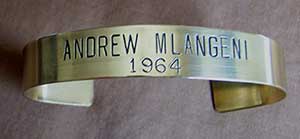
Participants in the Political Prisoners of South Africa Bracelet Program only removed their bracelet once the prisoner was released. (Image courtesy of Deborah Robinson.)
On her way back to Ann Arbor, Robinson reflected on what she had done to fight against apartheid, and asked herself what else she could do.
She thought back to junior high. The year was 1971, and Robinson had worn a bracelet bearing the name of an American POW in Vietnam. She remembered how it felt to have that personal connection to a soldier she’d never even met. So she decided to launch a similar project at U-M, demonstrating solidarity with the nameless victims suffering under apartheid in South Africa.
That gem of an idea evolved into the nonprofit organization International Possibilities Unlimited, founded in 1985, and its key initiative, the Political Prisoners of South Africa Bracelet Program. Robinson chaired the organization, staffed by volunteers. Together they raised funds to support anti-apartheid organizations by selling brass bracelets that bore prisoners’ names. Each came with a 26-page booklet, individual bio, and instructions on how to write to the family of the prisoner.
U-M students sold bracelets for $6.50 in the “Fishbowl” at Angell Hall, while local retailers Collected Works, Orchid Lane, and Shaman Drum sold bracelets — at no profit – on behalf of the program. The Washtenaw Coalition Against Apartheid also lent support and guidance.
Robinson recorded the contact information of each person who purchased a bracelet so she could notify them when the respective prisoner was released, at which time they could remove the bracelet.
“I wanted to affect people personally, because as you wear the bracelet, you think about that person,” she says.
Expanding awareness
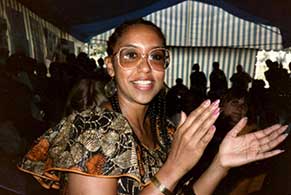
Deborah Robinson, wearing her bracelet, during a trip to Kenya in 1985. (Image courtesy of Robinson.)
The bracelets soon moved beyond Ann Arbor. Advocates representing churches, schools, and universities nationwide ordered product in bulk for sale through their own organizations. Eventually more than 5,000 bracelets found their ways to the wrists of people in some 40 states. Robinson talked with someone who had seen the bracelet on a participant at a youth conference in Russia, and a friend sent her a photo of a young woman in London who had a bracelet that she removed once the prisoner was released.
The organization raised $5,000 and Robinson traveled to South Africa twice to donate the funds, interview prisoners’ families, and visit prisoners on Robben Island. She ended the program in 1991 when all of the prisoners were released.
“This definitely had an incredible impact on my life,” says Robinson. “I have a second life in South Africa.”
Unlimited possibilities
Looking back, it seems unreal to Robinson that she launched the bracelet program while working on her dissertation at U-M. At the same time she was participating in a major project at the Center for African American Studies, and performing with a dance company.“I can’t believe I was doing all these different things,” she says laughing, noting that could well be the reason she took nine years to complete her doctorate in social psychology.
Today Robinson lives in Laurel, Md. She is academic director of SIT Graduate Institute’s Washington, D.C., Center, which offers degrees in sustainable development. She has visited South Africa 16 times over the years, and has traveled to 70 countries with a goal to reach 193 — all the member countries of the United Nations.
Lasting impact
History recently marked the 25th anniversary of Nelson Mandela’s release from prison (Feb. 11, 1990), and Robinson’s passion for the project still burns. Now 58, she’s the voluntary director of the Political Prisoners of South Africa Documentation Project, which aims to archive materials from the original program and make them available to scholars and the general public.
The collection includes correspondence between Robinson and prisoners’ families, audio/video interviews with prisoners and their families, and legal and financial documents related to the organization. There are letters from people who purchased the bracelets, as well, including a handwritten note from an eight-year-old girl who wrote, “I may be young but I want to help.” Another comes from a mother in New York, whose daughter sold 250 bracelets while in junior high.
Robinson hopes to digitize the materials and produce a permanent exhibit that could be hosted in South Africa. In the meantime, she hopes to locate as many participants as possible to record their impressions of the bracelet program for inclusion in the archive. She’s reconnected with 30 participants so far, and hopes to track down as many as possible.
Bracelet program participants are invited to visit www.sabracelets.org, where they can take a short survey and provide current contact information.
“Trying to find participants based on addresses that are 30 years old is almost impossible,” Robinson says.
Linked for life
In addition to prisoners and their families, Robinson also developed lasting friendships with U-M undergraduates who volunteered with the campus program. Martha McCaughey, now a professor of sociology at Appalachian State University, and Robin Feuchtwang (formerly Grant), were 20-year-old sociology majors when they learned of the bracelet program.
As a white person, McCaughey says she was increasingly becoming aware of racial privilege. “Something about the project really spoke to me.”
Working with Robinson helped define McCaughey’s methods in creating and participating in subsequent social movements. “[Robinson] is one of the most incredible people I’ve ever known,” she says. “She is someone I still look up to.”
There was a feeling of hopefulness and optimism to the program, adds Feuchtwang. So when apartheid, a seemingly intractable institution, ended, she says, “I felt like I played a teeny tiny piece in supporting that effort.”
After receiving her master’s degree in social work, Feuchtwang worked as program director at the Hillel Foundation at Northwestern University for five years, and now lives in Silicon Valley. She still uses many of the tools she learned by watching Robinson three decades ago.
Never forget

Deborah Robinson and Mr. David Moisi. He named his daughter after her. (Image courtesy of Robinson.)
For her part, Robinson continues to experience the effects of the program. She tells the story with astonishment of Mr. David Moisi, a former political prisoner who named his daughter after her — at his father’s urging. She met the daughter, now 20, in September 2014. The young woman told Robinson, “You were very supportive of the family. You were an activist and you really cared about South Africa and the plight of the political prisoners.” The father told her, “You came to our family when others wouldn’t visit.”
On a 2014 visit to South Africa, Robinson brought additional bracelets with her, since one family of a former political prisoner was eager for more.
“They give hope to the families, even now,” she says. “I don’t want these people to be forgotten. They made a sacrifice and their families made a sacrifice and people don’t know their names. They’re just symbols of all the political prisoners.”
No expiration date

In September 2014 Deborah Robinson visited Namibia and brought Mr. Malakia Shivute Ushona a newly produced bracelet bearing his name. He was one of 18 Namibian prisoners sentenced to life and included in the bracelet program. (Image courtesy of Robinson.)
Robinson says the bracelet program succeeded because it tapped into the fundamental idea of person-to-person solidarity.
“People connect with stories on a personal level,” she says. “If you can touch them personally, it can make the difference.”
She’s confident she would have proceeded with her program even if she was the only one wearing a bracelet. “If you believe in something strongly, you should just go for it,” she says.
In fact, once the bracelet program was in full swing, Robinson had an opportunity to connect with the South African man she met at that party in Detroit, and who, in part, inspired her grass-roots movement.
“He was blown away when I showed him the bracelet and the booklet,” she says. “We’re friends to this day.”

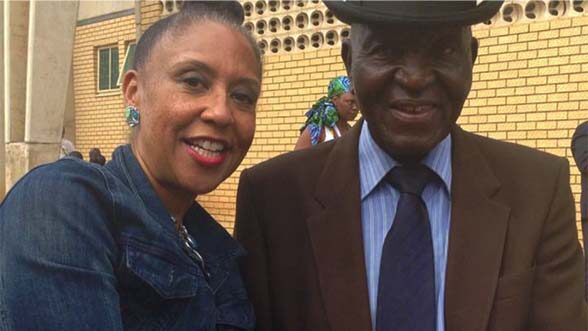
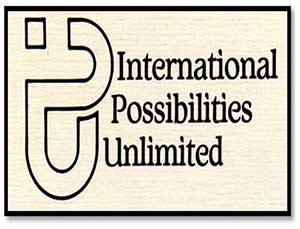
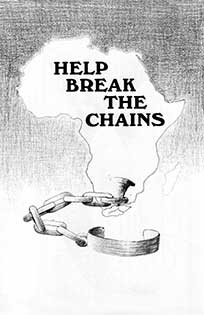


Kristin Cabral - 1988
This article stunned me. I not only still have my bracelet but a flyer for one as well. I bought my bracelet in the Fishbowl during my first-year as an undergrad in early 1985. I requested a bracelet with the name of a woman. My bracelet says Thandi Modise, 1980. I would love to meet Deborah as I am in Metro DC. She enlightened so many, including me.
Reply
Deborah Robinson - 1987
Kristin, I would LOVE to meet you and reconnect with as many former Bracelet Program participants as possible. We only had addresses of those who bought the bracelets via mail order; and even those are 30 years old now!!! I can share updated information regarding Thandi Modise. My goal with the website (under development) is to include information on what happened to the former prisoners after release. LET’S CONNECT!!! I guess the best way is through the website http://www.sabracelets.org. Thanks for commenting.
Reply
Kristin Cabral - 1988
Wonderful, Deborah! I signed up (hope you got my info). Please contact me. Justice is my life mission as I am an attorney. Human rights, inclusion, and diversity are key to our civil society. We must continue the struggle at home and abroad.
Reply
Horace Sheffield - 1995
As one who worked with Randall Robinson, and whose father was a pioneer labor and civil rights leader, this story continues to prove the power of one. So many people today dissuade themselves from opposing wrong or from addressing injustice because they are alone in their disgust. Be like Robinson and let that spark ignite something within you that lights a fire around the world. You Go Girl!
Reply
Deborah Robinson - 1987
Thank you for the kind words, Horace. We ALL have a part to play in fighting oppression and ensuring social justice. We all need to believe that, in some small way, we can make a difference.
Reply
Harriet Sandmeier - 1959
This is very inspirational. Deborah, thank you. But to the writer of the article…why in the world does her current age have relevance? Oh my gosh, there is so much more to be learned! 🙂
Reply
Ann-Nora Hirami - 1990
Fantastic work, and exactly the kind of article I want to see in our magazine. Although on campus when you were a doctoral student and these bracelets started, I am sorry to say I do not have one. I do, however, wear my “46664” bracelet for Nelson Mandela. A similar tribute. I am a high school teacher of Sociology and US History and love teaching in both classes about the country, movement, and the man. There is no one in the world I admire more. I similarly still wear a Vietnam War POW/MIA bracelet for someone never found, also BNR. The cause continues.
Reply